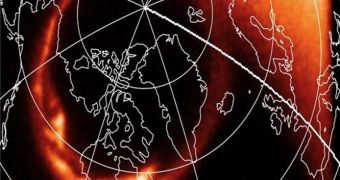Researchers at the University College London (UCL), in the United Kingdom, recently managed to observe the energetic particles that form the brightest auroras. This is the first time such a feat was accomplished, and the team behind the research says that their accomplishment was made possible through the use of the Cluster spacecraft. Details of the discovery were presented today, April 12, at the RAS National Astronomy Meeting (NAM2010), in Glasgow, Scotland, AlphaGalileo reports.
The science team that made the observations was led by UCL expert Dr Colin Forsyth, who also presented the findings at the meeting. He explains that auroras are formed as charged particles from the Sun slam into the upper portions of our planet's atmosphere. As this happens, they lose energy, and heat the molecules that exist at high altitudes, making them glow in beautiful red, green and blue nuances. The particles then flow along the Earth's magnetic lines, which is why some of them have a curtain-like appearance. Generally, the auroras can only be seen at the north and south poles.
At a height of 50,000 kilometers (31,000 miles) above the planet, some peculiar processes take place. Particles are accelerated considerably, before they have sufficient energy to excite the auroras. These phenomena are not well understood, and researchers know that they are key to understanding the atmospheric lights themselves. In order to gain more insight into these phenomena, the UCL team used the four identical satellites of the Cluster mission, which is a collaboration of NASA and the European Space Agency (ESA). The constellation was launched 10 years ago, and it orbits the planet in close formation, with one spacecraft trailing closely after the other.
One of Cluster's outstanding features is that is allows experts to create a 3D picture of the magnetosphere, the atmosphere's protective layer, that shields us from cosmic radiation and most solar flares. This is only possible through the multi-point perspective that the four satellites provide. “The Cluster spacecraft have been maneuvered such that one of them was at a higher altitude than the others when they passed over the auroral regions. We were then able to simultaneously measure the particle energies at different heights and thus their acceleration. These exciting new results will give us new insight into the accelerating processes and the transfer of energy from the magnetosphere into the atmosphere,” the team leader said at the meeting.

 14 DAY TRIAL //
14 DAY TRIAL //